|
December 04, 2006 (IAS, Princeton): Press Release
EMBARGOED UNTIL 5 P.M. DECEMBER 4, 2006
Segregation: Society as a liquid or a solid
PRINCETON, N.J., December 4, 2006 – A new study in the Proceedings of the National Academy
of Science (PNAS) written by Dejan Vinković, a physicist and former Member in the
School of Natural Sciences and current Visitor in the Program for Interdisciplinary
Studies at the Institute for Advanced Study, and Alan Kirman, an economist from
GREQAM, EHESS, Université d'Aix-Marseille, who was a Member of the Institute
last year, brings a new insight into the Schelling model of socio-economic
segregation in society. In this study, the team presents a mathematical link
between Schelling’s model and models used for solving the physical problem
of surface tension force in liquids and solids.
Segregation is an important sociological and economic phenomenon where people
cluster together according to some shared similarity such as race, nationality,
income or education level. Some 40 years ago, Thomas Schelling, who won last
year's Nobel Prize in economics, suggested a simple model to explain this phenomenon.
He constructed a model where individual housing properties are approximated with
squares on a checkerboard. Squares are colored according to the race of the occupant.
Then he played a game where people unhappy with their current neighborhood move
to areas that they prefer. The result was surprising: even if individuals have
a relatively mild preference for not being outnumbered by neighbors of
a different color, total segregation may emerge.
Since Schelling introduced the model, many variants have been proposed and studied
by economists and sociologists puzzled by this emergence of unintended macroscopic
phenomena from seemingly small and uncoordinated individual actions. The study by
Vinković and Kirman brings a new insight into these models, showing that the structure
of the Schelling model is undistinguishable from models used for solving the physical
problem of surface tension force in liquids and solids.
“Using this analogy, we reveal the mechanism that generates racial clustering and explain how the shape and stability of the clusters depend on the rules governing the movement of individuals and the amount of free space available,” Kirman explains. “As the appropriate parameters are changed the clustering can yield solids, liquids or glass-like structures. ”
Replacing people with lifeless particles may seem strange, but Vinković disagrees: “The intuition is simple. In the economic system people can be described as ‘unhappy’ or having ‘low utility.’ Economic models are, therefore, focused on increasing people's happiness or utility. In the physical system we are solving exactly the same problem, only the terminology is different; we deal with particles with high energies and systems which try to minimize their energy.”
“When dealing with people, the model creates city quarters populated by people with a similar attribute, while when dealing with particles, the model may create a crystal or a liquid droplet,” Kirman adds. “The liquid situation corresponds in the social model to one in which there are always people who are changing locations.”
The authors point out that their physics analogy can be used to examine the size, shape and evolution of the empirically observed segregated zones in cities and to compare these with the model's predictions. Moreover, similar clustering phenomena appear in other social animals and thanks to this analogy scientists can better understand the dynamics of such biological systems.
Contact:
Dejan Vinković: dejan_AT_ias.edu
Alan Kirman: alan.kirman_AT_univmed.fr
Preprint: Vinkovic, D. & Kirman, A. 2006, PNAS, 103(51), 19261
(PNAS,
PDF)

According to the new study, just by looking at this model of red and blue moving squares we cannot say if this represents people in a town or particles in a liquid. This confusion is the basis for the analogy between models of social segregation and physical systems of surface tension force.
( HighRes figure)
|

Example of the model
Thomas Schelling's model of segregation is an example of global dynamics
emerging from individual decisions of many people.
A social group without preferences for segregated neighborhoods can end up
completely segregated when individulas have just a mild
preference for same-type neighbors.
In the end of the 60's Tom Schelling introduced a model of
segregation in which individuals, living on a lattice, chose where
to live on the basis of the color of their neighbors. He showed that
even if people only have a very mild preference for living with
neighbors of their own color, as they move to satisfy these
preferences, complete segregation will occur. This result is
considered surprising and has generated a large literature. The
Schelling result is of interest to economists because it illustrates
the emergence of an aggregate phenomenon which is not directly
foreseen from the individual behavior and because it concerns an
important economic problem, that of segregation.
See also:
Vinkovic, D. & Kirman, A.
''Schelling's model with income preferences and a housing market''
2009, mimeo GREQAM, Marseille
(PDF)
Non-periodic boundary - Box
"Liquid global cluster"
| utility: |
1 if unlike <= 0.5
|
|
0 if unlike > 0.5 |
number of red cells = 4000
number of blue cells = 4000
number of empty cells = 2000
swapping particles = off
jumping only to the nearest acceptable neighbors = off
move if the utility does not change = on
Download: Animated GIF
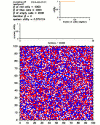
|
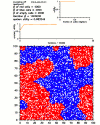
|
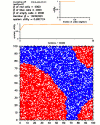
|
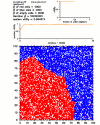
|
|
initial
|
1 mil. steps
|
10 mil. steps
|
50 mil. steps
|
"Liquid surface global cluster"
The same as "Liquid global cluster", except that agents have to move to the closest available location:
jumping only to the nearest acceptable neighbors = on
The result is very similar to "Liquid global cluster", but the cluster evolution is much slower
because movements are short-range, as if only the cluster surface wobbles (surface waves).
Download: Animated GIF
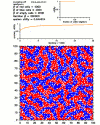
|
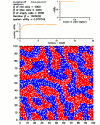
|
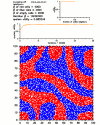
|
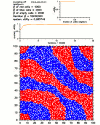
|
|
0.2 mil. steps
|
1 mil. steps
|
10 mil. steps
|
50 mil. steps
|
"Liquid mixing surface global cluster"
The same as "Liquid global cluster", except that
swapping between agents is allowed.
If agents have to move to the closest available location:
jumping only to the nearest acceptable neighbors = on
swapping particles = on
The result is still somewhat similar to "Liquid global cluster", but the cluster evolution is very slow
because movements are short-range and not constrained only to the empty space.
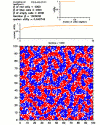
|
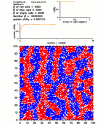
|
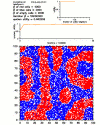
|
|
1 mil. steps
|
10 mil. steps
|
50 mil. steps
|
If agents can jump to any distance:
jumping only to the nearest acceptable neighbors = off
swapping particles = on
The result is still similar to "Liquid global cluster", but the cluster evolution is very quick
because movements are long-range and not constrained only to the empty space.
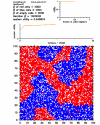
|
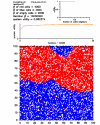
|
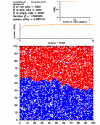
|
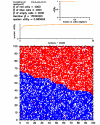
|
|
1 mil. steps
|
10 mil. steps
|
11.8 mil. steps
|
15.5 mil. steps
|
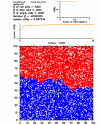
|
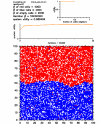
|
|
|
|
42.2 mil. steps
|
50 mil. steps
|
|
|
"Frozen liquid global cluster"
The same as "Liquid global cluster", except that agents can move only if their utility increases:
move if the utility does not change = off
The outcome is a quick freeze of the system in which clusters are solidified and can not merge
into one compact cluster.

|

|

|

|
# red = 3000
# blue = 3000
# empty = 4000
|
# red = 4000
# blue = 4000
# empty = 2000
|
# red = 4900
# blue = 4900
# empty = 200
|
# red = 2900
# blue = 6900
# empty = 200
|
"Solid clusters"
| utility: |
1 if unlike <= x
|
|
0 if unlike > x |
# of red = # of blue = 5000 - empty/2
Only short moves are allowed:
swapping particles = off
jumping only to the nearest acceptable neighbors = on
move if the utility does not change = off
| empty=200 | empty=1000 | empty=3000 |
| x=0.375 |
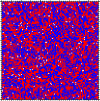
|
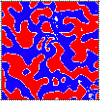
|
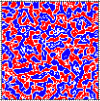
|
| x=0.5 |
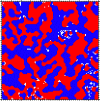
|
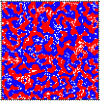
|
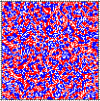
|
| x=0.625 |
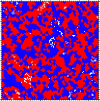
|
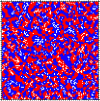
|
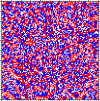
|
Long jumps are are allowed:
swapping particles = off
jumping only to the nearest acceptable neighbors = off
move if the utility does not change = off
| empty=200 | empty=1000 | empty=3000 |
| x=0.375 |
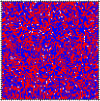
|
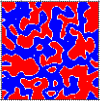
|
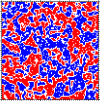
|
| x=0.5 |
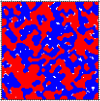
|
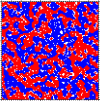
|
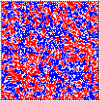
|
| x=0.625 |
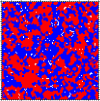
|
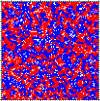
|
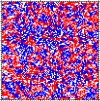
|
"Liquid clusters"
| utility: |
1 if unlike <= x
|
|
0 if unlike > x |
# of red = # of blue = 5000 - empty/2
swapping particles = off
jumping only to the nearest acceptable neighbors = on
move if the utility does not change = on
|
1 mil. steps
| empty=200 | empty=2000 |
| x=0.375 |
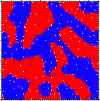
|
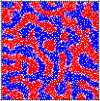
|
| x=0.5 |

|

|
| x=0.625 |

|

|
|
10 mil. steps
| empty=200 | empty=2000 |
| x=0.375 |
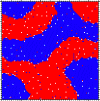
|
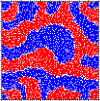
|
| x=0.5 |

|

|
| x=0.625 |

|

|
|
50 mil. steps
| empty=200 | empty=2000 |
| x=0.375 |
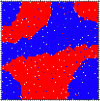
|
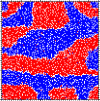
|
| x=0.5 |

|

|
| x=0.625 |

|

|
Periodic boundary - Torus surface
"Liquid global cluster"
| utility: |
1 if unlike <= 0.5
|
|
0 if unlike > 0.5 |
number of red cells = 4000
number of blue cells = 4000
number of empty cells = 2000
swapping particles = off
jumping only to the nearest acceptable neighbors = off
move if the utility does not change = on
EXAMPLE 1: clusters do not touch their mirror clusters and, therefore, a spherical blob is formed.
Download: Animated GIF

|

|

|
|
1 mil. steps
|
10 mil. steps
|
50 mil. steps
|
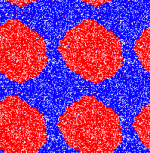 Mosaic based on periodic boundary conditions after 10 million steps.
Mosaic based on periodic boundary conditions after 10 million steps.
EXAMPLE 2: clusters touch their mirror clusters and form a stripe
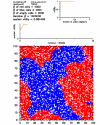
|
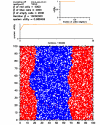
|
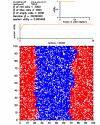
|
|
1 mil. steps
|
10 mil. steps
|
30 mil. steps
|
"Liquid surface global cluster"
The same as "Liquid global cluster", except that agents have to move to the closest available location:
jumping only to the nearest acceptable neighbors = on
The result is very similar to "Liquid global cluster", but the cluster evolution is much slower
because movements are short-range, as if only the cluster surface wobbles (surface waves).
Download: Animated GIF

|

|

|

|
0.2 mil. steps
|
1 mil. steps
|
10 mil. steps
|
50 mil. steps
|
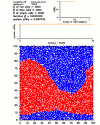
|
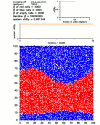
|
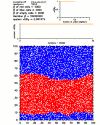
|
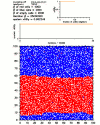
|
|
100 mil. steps
|
150 mil. steps
|
200 mil. steps
|
225 mil. steps
|
"Uneven liquids"
The same as "Liquid surface global cluster", except that the utility function is different
for red and blue agents:
xred=0.375
xblue=0.625
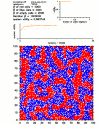
|
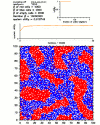
|
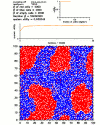
|
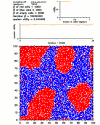
|
1 mil. steps
|
10 mil. steps
|
50 mil. steps
|
100 mil. steps
|
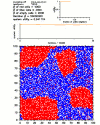
|
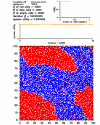
|
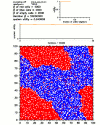
|
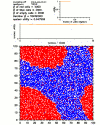
|
|
150 mil. steps
|
200 mil. steps
|
250 mil. steps
|
300 mil. steps
|
|